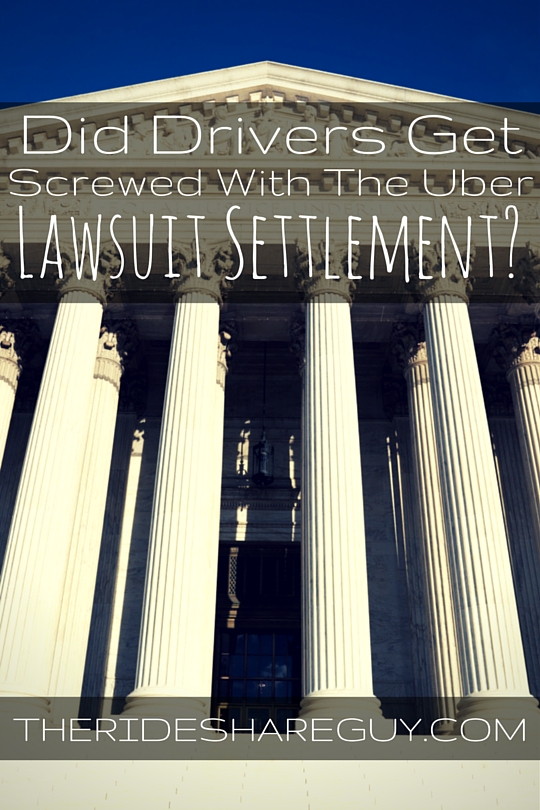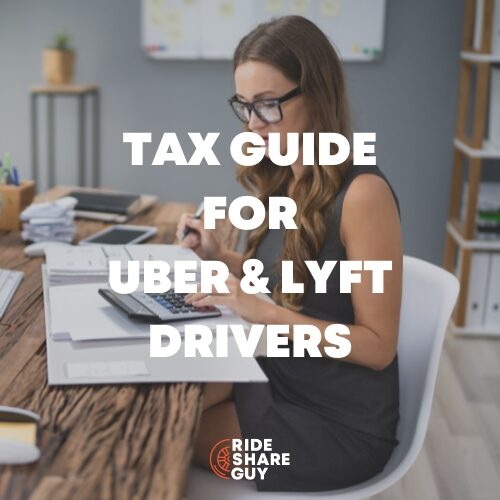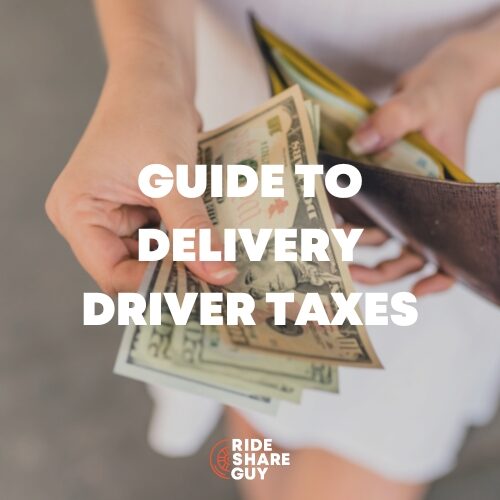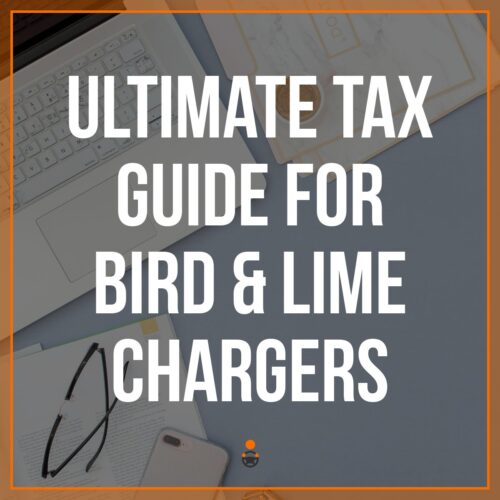A couple weeks ago, news broke that the Uber Misclassification Lawsuit in California had been settled. This came as a big surprise to me and many others who’d been watching the case. But now that some time has passed, I wanted to break down what it means for all parties involved.
The first thing that drivers need to understand is that this settlement still needs to be approved by Judge Chen. There’s a preliminary approval hearing on June 2 and we may know more about the details and time-line then, but with a case this big, even the settlement process (if it’s approved) could extend well into 2017. So drivers looking to get paid will have to be very patient.
Uber has already started implementing some of the non-monetary concessions from the settlement like the driver deactivation policy (nationwide) and an appeals process for deactivations. Although to be fair, Uber started piloting the latter in Seattle months ago, so even though it’s technically included in the settlement, it seems like they were planning on doing it anyways.

It Seems Like Uber Is The Big Winner Here
It’s not often that being forced to pay out $84 million makes you “the big winner”, but I have to imagine there were a lot of people at Uber who did their happy dance when this settlement came down. This was a big case and in addition to all the media coverage, a defeat could have had a huge impact on their valuation.
The Biggest Risk to Uber’s Valuation
Uber probably isn’t going public any time soon, but they’re still actively raising money, and labor classification (employee vs 1099) has always been one of the biggest threats to its valuation. An $84 million settlement might seem like a lot of money, but when you compare it to Uber’s most recent valuation of $62.5 billion, it’s pretty minuscule. In fact, it’s only .13% of their current valuation!
Losing this lawsuit (or even going to trial) could have cost them a lot more than a couple percentage points on their valuation, so from a valuation-risk perspective, this settlement was a big win for Uber. And going forward, the settlement could will be used as ammunition in their next round of fund-raising to seek an even higher valuation.
How Much Should Uber Pay?
Per chi1cabby on UberPeople, this case was settled for 15% of the total damages based off on-trip miles (the amount of time with a passenger in the car). It’s pretty hard to tell exactly what amounts, percentages and miles were used for this settlement because most of the pertinent financial figures are blacked out. But right off the bat, we know that ‘rider miles’ is not an accurate representation of the total miles an Uber driver drives.
If we look at Uber’s own blog post from the end of 2015, we see that on-trip miles only make up about half of a driver’s time. Taxi drivers have told me that they do about 2 unpaid miles for every paid mile and in my experience, Uber drivers are more efficient but still log around 1 unpaid mile for every paid mile.
(Unpaid miles come in the form of driving to pick-up a passenger after you accept the request, driving around looking for passengers (usually not a good idea but lots of drivers do it) and driving into/out of the city since most drivers can’t afford to live in the city centers where it’s busiest.)
If both parties would have used ‘real mileage’ calculations, the potential reimbursement would have at least doubled making the 15% they settled on only 7.5%. If we look at the very similar Lyft lawsuit, Judge Chhabria actually rejected the settlement offer of $12.25 million, which was only around 10% of the re-calculated potential damages of $126 million, citing that it was too low of an amount.
Uber and SLR obviously have the right to settle on whatever % they want, but the judge still has to approve that amount. So it wouldn’t surprise me if the judge in this case (who always seemed pretty skeptical of Uber’s treatment of drivers) gave drivers a bigger monetary settlement.
Want To Do Some Reading?
Admittedly, I haven’t read through every page yet, but there is some interesting information if you’d like to read some of the briefs that have been filed so far.
Motion For Preliminary Approval
Lyft denying motion for preliminary settlement
What Did Drivers Get Out Of All This?
My immediate reaction to this settlement is that drivers got screwed. If you were for this lawsuit and wanted to be an employee, you were probably pissed because you basically lost the case. If you were like me and didn’t want to be an employee (but wanted more of a true IC relationship), you probably still feel like Uber got off too easy and/or the lawyers got too much money.
And I think the big reason for those feelings is because there’s not a lot of immediate impact for drivers. The money won’t amount to much when split up among 385,000 drivers, and a lot of the concessions that Uber made sound great on the surface but who knows how they’ll actually play out in real life.
Drivers Will Remain Independent Contractors
I think most drivers want to be independent contractors, but the problem is that as an Uber driver, you’re not a true independent contractor. You obviously have some say in when and where you work, but with things like guaranteed pay that require you to work only in certain areas and only during certain times, how is that independent? There are countless other examples that illustrate this point.
But conversely, I also understand that Uber wouldn’t function well if drivers were completely free to set their own rates (Sidecar anyone?) and accept only the most profitable rides (i.e. no short min. fare rides). Taxi drivers used to be notorious for cherry-picking longer fares since they were more profitable and it’s one of the reasons why Uber has become so popular with consumers – they don’t allow that.
But I also think there’s a lot of room for middle ground and compromise. As it stands now, Uber sets the rates and they tell drivers ‘this will be good for you, trust us’, which is analogous to a stranger offering you free candy. Probably not a good idea. But if we had ‘some say’ in what those rates were, maybe we wouldn’t be so bitter about driving 15 minutes to pick up a passenger who wants to go two blocks for a net $2.40.
Drivers’ Association
This is one of those concessions that sounds great on paper but I remain cautiously optimistic about it. Organizing hundreds of thousands of drivers is no small feat and if Uber’s going to pay for it, that’s potentially millions of dollars on the table.
So it’s no surprise that organizations like the Teamsters have pounced on the opportunity to ‘represent Uber drivers’. If it turns out that an organization like that is the one representing Uber drivers, I can’t imagine that they would have driver’s best interests at heart and the value of this association would decline rapidly for me.
Related Post: How To Organize A Group Of Uber Drivers
But let’s imagine that a group of drivers were elected by the drivers themselves and The Teamsters helped organize that group. That could be an organization that really ends up benefiting drivers since they’d be able to formally meet with Uber and potentially come to a compromise on a lot of the issues that drivers face on a daily basis.
Published Deactivation Policy
I think it’s great that Uber has finally published their deactivation policy, but why did it take a settlement to get this concession? Isn’t this a standard thing at every company you’ve ever worked for? Transparency is always a good thing but this ranked pretty low on the list of concessions for me, especially since anyone who reads this blog should already know about a lot of these reasons.
No Deactivations For Low Acceptance Rates
Again, not being deactivated for low acceptance rates is something that would really benefit drivers, but we need to see how it plays out in real life. The wording in the settlement already hints that drivers will be ‘timed out’ for not accepting enough rides but how long will the time out be? Is it 2 minutes, 2 hours or 2 days?
We know there are big problems with UberPool for example, with drivers complaining incessantly about these requests and many of them flat out refusing to do them (we call that peeing in the pool). And I feel the same way: I don’t think drivers are fairly compensated for the increased workload on UberPool rides. Based off the new policies, it sounds like drivers will be able to decline/ignore every second Pool request or even the first Pool request. That would cause a lot of reliability problems for Uber, so how will they combat it? Will they deactivate a bunch of drivers or will they raise the compensation for UberPool rides?
My hope is that in this type of situation they would recognize a problem and address it in a way that makes sense for all parties involved. But if we go based off past history, that just hasn’t happened very often. Most of Uber’s solutions and policies are beneficial to customers and passengers instead of the drivers.
Drivers Can Now Still Accept Tips
Tipping has always been a polarizing issue for drivers and Uber. Many passengers are under the impression that tip is included in their fare, and Uber hasn’t done much to dissuade that line of thinking. When drivers were making more money, no one complained about the lack of tipping but now that wages have gone down, a $1 or $2 tip could mean a 10-20% boost in your hourly income. So yeah, it’s a big issue.
With the settlement, Uber drivers will now be allowed to post a sign in their car that says something to the effect “Tips are not included, they’re not required, but they are appreciated.” Now personally, I was under the impression that you could always do this, but I guess the settlement clarified this point.
I’m actually kind of excited for this part of the settlement since I think if enough Uber drivers put these annoying signs in their car, riders will complain about it to Uber to the point where they have to at least consider adding an in-app tip option. It’s a long shot but it’s already generated a lot of media buzz and forced Uber to comment on it for the first time.
Stay tuned for next week’s article (subscribe to our e-mail list here) as we’ll be testing out some ‘tipping’ signs while driving for Uber and seeing what type of reactions AND TIPS we get!
Should This Case Have Been Settled?
In the aftermath of everything, this is really the big question: should this case have been settled? Now I’m not a lawyer, but I do know how to read, and over the past couple weeks, I’ve read a lot about the potential challenges this case was going to face.
According to SLR, the biggest risks to this case were a recent ruling by the Ninth Circuit court of appeals that would have reviewed Judge Chen’s (district court) orders on arbitration and class certification and the possibility of a jury siding with Uber. The latter was always a risk of this case, so I’m not so sure it can be used as a reason to settle unless a settlement is what they were after in the first place.
On the first point though, it took me a while to understand the Ninth Circuit Court of Appeals’ review but in short what it means is that currently, the class of drivers sits at 240,000. If the Ninth Circuit court of appeals reversed Judge Chen’s class certification ruling, the class would go from 240,000 drivers to 8,000 drivers. Additionally, even if the Ninth Circuit agreed with Judge Chen on the class action, Uber could still appeal to the Supreme Court, which Uber indicated they would do (but there’s no guarantee the Supreme Court would have heard this case).
SLR says that the reason why this is important though is because even if Uber were to lose at trial for those 8,000 drivers, they would still not be forced to pay out a single penny to the other 232,000 drivers or even classify workers as employees. Those other 232,000 drivers would have had to file individual arbitration cases against Uber, but my guess is that if Uber lost the case for 8,000 drivers, it would set pretty good precedent for those individual drivers to file.
So in essence, this case was settled in order to get at least something for 240,000 drivers instead of having to fight for employee status for only 8,000 drivers.
Were The Lawyers The Big Winners?
A lot of the feedback I’ve gotten from drivers about this settlement has been pretty negative. Like I said, those who wanted to be employees were upset, but even those who wanted to be independent contractors had similar feelings of anger. I think a lot of that anger stems from the fact that Uber’s concessions won’t have much of an immediate impact on drivers and the lawyers in this case made a lot of money.
According to the settlement docs, SLR’s law firm stands to recover 25% of the damages, or $25 million (25% is standard for class action lawsuits). Anyone who’s been involved in class actions before can tell you that high payouts for the lawyers involved are typical, so the amount shouldn’t come as much of a surprise. Lawyers in class-action suits don’t get paid a single penny until there’s a settlement or they win the trial. So that means they get nothing if they lose and when you weigh $25 million vs the prospect of fighting for another 5-10 years and potentially getting zero, it’s pretty hard for anyone to say no to a settlement.
Now I’m not going to say the lawyers in this case sold out, but you have to admit that by nature, class actions incentivize settlements. Drivers weren’t looking for payouts with this lawsuit, they were looking for structural change and they did not get it. Sure, it may come eventually, but as of today, no real change has happened and that is a fact.
It’s a little bit depressing, but drivers are really the ones who get screwed in these types of situations. Uber gets off with a slap on the wrist, the lawyers get rich and it also opens up the door for future lawsuits. In fact, it wasn’t long before two new class action lawsuits (excluding drivers in CA/MA) were filed. Uber is obviously going to fight these in the same capacity as the CA lawsuit, and ultimately they’ll probably end up settling in exchange for a few more minor concessions if they even make it to trial.
It’s always possible that Uber will start listening more to drivers, help form associations that represent driver’s best interests, give drivers more freedom with their acceptance rate and maybe even add an in-app tipping option. But that’s a lot of what if’s. I’m an optimistic person by nature, but the reality is that it’s hard to affect change from a $62.5 billion company if they don’t want change to happen. Lawyers probably aren’t going to be able to solve this problem, so ultimately, it’s up to the government. And so far, they haven’t fared too well either going up against Uber.
Unhappy With The Settlement?
If you’re unhappy about this settlement, you have a few options to voice your concerns. I suggest the following:
- You can contact the court directly (Instructions here: Page 135, #20) at: Clerk of the Court U.S. District Court, N.D. Cal. 450 Golden Gate Avenue, 17th Floor San Francisco, CA, 94102 Uber Class Action Settlement Settlement Administrator
- You can contact Judge Chen directly here
- You can contact Shannon Liss-Riordan, the lawyer representing the class at www.uberlawsuit.com or via e-mail at uberlawsuit@llrlaw.com
How do you feel about the settlement?
I’d love to get your take on the settlement so feel free to leave a more detailed comment in the comments section below.
FAQ
How much will I get from this settlement?
The amount you receive will be based on the total number of miles you drove. If you drove 25,000 miles or more, you could receive a few thousand dollars or more. The average driver will receive only a couple hundred dollars or less though.
When will I get my money from this settlement?
The settlement still needs to be approved by Judge Chen, but if it’s approved, it might still take up to a year to get payments processed.
Does this settlement apply only to drivers in CA/MA?
The monetary settlement only applies to drivers in CA/MA, but some of the non-monetary concessions like the driver deactivation policy will apply to drivers everywhere. Other items like the driver’s association will start out in CA/MA and potentially be rolled out to every state but there’s no legal requirement to do so.
Drivers, what do you think about the Uber settlement now that a couple weeks have passed since the news came down? Do you think drivers could have gotten more out of the settlement or should SLR have taken this thing to the finish line regardless of the risks?
-Harry @ RSG




